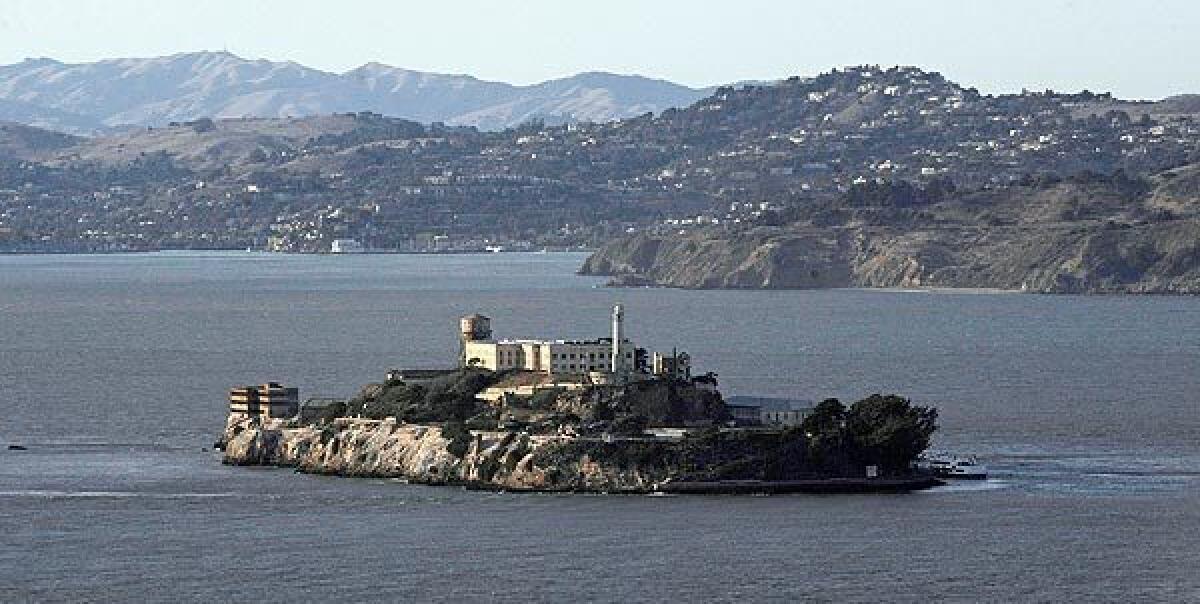Trump’s call to reopen Alcatraz falls flat with tourists, who ask: Why and how?

- Share via
ALCATRAZ ISLAND, Calif. — The exhibits on Alcatraz Island, the infamous federal prison that decades ago was shuttered and preserved as a national park site and tourist attraction, invite visitors to imagine what it was like to be a guard or an inmate confined to the lonesome, foggy rock in the middle of San Francisco Bay.
But on Monday, a day after President Trump posted on social media that he wants to reopen the nearly century-old prison as a “substantially enlarged and rebuilt ALCATRAZ, to house America’s most ruthless and violent Offenders,” many tourists were imagining a very different role: what it would be like to be the construction manager who might actually have to figure out how to make that happen.
“I’m all for what [Trump] is doing, but this doesn’t make sense,” said Beverly Klir, 63, an ardent Trump supporter who was visiting from Chicago. “I believe Gitmo [the prison at Guantanamo Bay] may be better. That’s where they all belong. They don’t belong here.”
She and her husband were standing amid a riot of pink flowers on the island’s craggy bluffs, looking out at the Golden Gate Bridge as a pair of Canada geese and three fuzzy ducklings waddled by. Behind them loomed the prison, its fortress-like facade menacing in appearance, but also a testament to age and weather, with crumbling stucco, deteriorated masonry and leaking joints.
Higher up on the island, outside the three-story cellhouse where some of the nation’s most incorrigible prisoners were once locked away in primitive cells, 10-year-old Melody Garcia, visiting with family from Concord, appeared equally perplexed. “Most of Alcatraz is broken down and stuff,” she said.
Still, within hours of Trump’s pronouncement, the Bureau of Prisons released a statement saying it was already on the job.
“The Bureau of Prisons will vigorously pursue all avenues to support and implement the President’s agenda,” said bureau Director William K. Marshall III. “I have ordered an immediate assessment to determine our needs and the next steps. USP Alcatraz has a rich history. We look forward to restoring this powerful symbol of law, order, and justice.”
Many California officials, meanwhile, responded with a range of ridicule and concern. A spokesperson for Gov. Gavin Newsom dismissed the pronouncement as a ploy designed to distract voters from Trump’s actions as president. State Sen. Scott Wiener (D-San Francisco) called it “unhinged.” But he also cautioned that “when Donald Trump says something, he means it,” and speculated that Trump may want to “open a gulag here in the U.S.”
The U.S. government’s presence on Alcatraz began in the 1850s, with construction of a fort bristling with cannons to defend San Francisco from hostile ships.
Soon after, U.S. officials also began using it as a military prison. During the Civil War, the crew of a Confederate ship, along with Union soldiers convicted of rape, murder, desertion and other offenses, were imprisoned there. The U.S. Army also locked up Hope, Apache and Modoc Indians there and, later, conscientious objectors to World War I.
In 1934, Alcatraz opened as an official federal prison for men who had made escape attempts from other federal prisons, or otherwise misbehaved. Among its notable inmates were Al Capone and George “Machine Gun” Kelly.
Known as “the Rock,” the prison, which had capacity for 336 men, earned a place in popular culture as an island of remote despair. “Everybody wants to be an individual,” said former inmate James Quillen, who served 10 years there, from 1942 to 1952. “You want to be human. And you weren’t at ‘the Rock.’”
In addition to being formidable, the prison was fearsomely expensive to maintain and operate. So expensive, in fact, that in 1963, then-Atty. Gen. Robert F. Kennedy ordered it closed.
John Martini, an Alcatraz historian, said the prison was closed in part because it was built with flawed construction methods and was decaying, and it “would be such a money pit to bring it up to standards ... that it was easier to build a new penitentiary.”
Six years later, the island acquired a prominent place in Native American history when a group of Native American activists landed on the island, declaring they were taking it in the name of “Indians of All Tribes.” The occupation lasted 19 months, and helped awaken the nation to the concerns of Indigenous Americans.
When federal agents moved in to remove the last occupiers in 1971, officials had plans to bulldoze the entire thing. But in 1972, Congress created the Golden Gate National Recreation Area, and the island instead became one of San Francisco’s most beloved attractions. More than 1.4 million people visit each year, walking through the dank cell blocks and taking in exhibits on the Native American occupation.
In calling for Alcatraz to be reopened, Trump said its restoration would “serve as a symbol of law, order, and justice.”
But the Golden Gate National Parks Conservancy, a nonprofit that helps preserve and support operations at Alcatraz, issued a statement Monday saying the prison’s stature as a historic landmark and educational destination already serves an important role.
“Alcatraz hasn’t been a working prison for over 60 years,” the organization said in its statement. “Today, it’s a powerful symbol — a National Historic Landmark preserved for all time, a transformative national park experience and global site of reflection. ... This is where history speaks — and where we learn from the past to shape a better future. “
John Kostelnik, western regional vice president of the Council of Prison Locals 33, said the idea of reopening Alcatraz was not only an “irresponsible” use of federal money but also a slap in the face to prison guards, who have long complained about low wages.
“It just seems very hypocritical that they came in and said they’re going to make government more efficient and DOGE and all that stuff,” Kostelnik said, using the acronym for Elon Musk’s cost-cutting team, “and now they’re saying they’re gonna throw hundreds of millions of dollars at a symbol.”
In December, the Bureau of Prisons said it was closing its troubled federal prison in Dublin, Calif., about 30 miles east of San Francisco, as well as five minimum-security prison camps in states from Florida to Colorado. The bureau said in a document obtained by the Associated Press that it was closing the facilities to address “significant challenges, including a critical staffing shortage, crumbling infrastructure and limited budgetary resources.”
San Francisco Mayor Daniel Lurie’s office directed inquiries about the Alcatraz proposal to the National Park Service, which did not immediately respond to a request for comment.
Tourists roaming the island Monday seemed preoccupied with two questions: How and why?
“It’s not ready. It is in no way, shape or form ready,” said Daniel Mulvad, 24, who lives in San Francisco and was visiting with guests from out of town. He noted that the costs of renovating the structure would be astronomical and seemed senseless given that, as a tourist attraction, Alcatraz appeared to be generating a great deal of revenue through ticket sales and merchandise.
“You’d have to really … rewire,” said Alyssa Sibley, 26, of Sacramento, as she stood in the old shower room, staring at the crude and rusting bathroom fixtures.
Tumidei Valentin, 34, a French psychologist vacationing in California, decried it as a “terrible idea.” “Every day he has new ideas,” Valentin said of Trump, most of them “to make a buzz” and get attention.
Kristin Nichols, 60, of Palm Springs, who was visiting with family, said that as someone who is part Chickasaw she was particularly moved by the exhibits about the Native American occupation.
“The amount of money it would take to do this…” she said. “I would question the purpose.”
She added: “It’s a historic place, and if they turn it back into a prison, it’s going to ruin all the history.”
More to Read
Sign up for Essential California
The most important California stories and recommendations in your inbox every morning.
You may occasionally receive promotional content from the Los Angeles Times.












